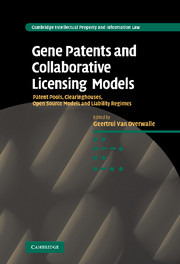 Gene Patents and Collaborative Licensing Models
Gene Patents and Collaborative Licensing Models Book contents
- Frontmatter
- Contents
- List of contributors
- Preface
- Foreword: Jean-Jacques Cassiman
- List of abbreviations
- Part I Patent pools
- Part II Clearinghouses
- 5 Clearinghouse mechanisms in genetic diagnostics. Conceptual framework
- 6 Case 3. The Global Biodiversity Information Facility (GBIF). An example of an information clearinghouse
- 7 Case 4. BirchBob. An example of a technology exchange clearing house
- 8 Case 5. The Public Intellectual Property Resource for Agriculture (PIPRA). A standard license public sector clearinghouse for agricultural IP
- 9 Case 6. The Science Commons Material Transfer Agreement Project. A standard licence clearinghouse?
- 10 Case 7. The collective management of copyright and neighbouring rights. An example of a royalty collection clearinghouse
- 11 Comment on the conceptual framework for a clearinghouse mechanism
- Part III Open source models
- Part IV Liability regimes
- Part V Different perspectives
- Part VI Summary and concluding analysis
- Index
- Titles in the series
7 - Case 4. BirchBob. An example of a technology exchange clearing house
from Part II - Clearinghouses
Published online by Cambridge University Press: 14 January 2010
- Frontmatter
- Contents
- List of contributors
- Preface
- Foreword: Jean-Jacques Cassiman
- List of abbreviations
- Part I Patent pools
- Part II Clearinghouses
- 5 Clearinghouse mechanisms in genetic diagnostics. Conceptual framework
- 6 Case 3. The Global Biodiversity Information Facility (GBIF). An example of an information clearinghouse
- 7 Case 4. BirchBob. An example of a technology exchange clearing house
- 8 Case 5. The Public Intellectual Property Resource for Agriculture (PIPRA). A standard license public sector clearinghouse for agricultural IP
- 9 Case 6. The Science Commons Material Transfer Agreement Project. A standard licence clearinghouse?
- 10 Case 7. The collective management of copyright and neighbouring rights. An example of a royalty collection clearinghouse
- 11 Comment on the conceptual framework for a clearinghouse mechanism
- Part III Open source models
- Part IV Liability regimes
- Part V Different perspectives
- Part VI Summary and concluding analysis
- Index
- Titles in the series
Summary
Introduction
BirchBob is a private company offering services to both technology holders (patent owners) and technology users in order to allow them to perform better in the global technology marketplace. These services are not limited to any particular technology sector or discipline. BirchBob assists universities, research institutes and industry and has clients with different profiles, varying from laboratories to manufacturers.
The BirchBob platform was launched in 1999 in the US. The name ‘BirchBob’ is a tribute to Senators Birch Bayh of Indiana and Robert Dole of Kansas, who co-sponsored the so-called Bayh-Dole Act. Enacted on 12 December 1980, the Bayh-Dole Act created a uniform patent policy among the many federal US agencies that fund research by enabling small businesses and non-profit organizations, including universities, to retain title to inventions made under federally funded research programs, and encouraging universities to collaborate, to file patents on inventions and to promote the commercial use of those inventions through technology transfer activities.
Since its inception in 1999 BirchBob has been cooperating with key US universities such as the University of Harvard, John Hopkins and the University of California and from 2003 onwards BirchBob has gradually been expanding its network of technology providers to five continents.
BirchBob's business model involves various services which ultimately facilitate access to patented technology and in some cases also the use of the technology by setting the scene for licensing negotiations. In doing so, BirchBob could be classified as a “technology exchange clearinghouse”.
- Type
- Chapter
- Information
- Gene Patents and Collaborative Licensing ModelsPatent Pools, Clearinghouses, Open Source Models and Liability Regimes, pp. 125 - 134Publisher: Cambridge University PressPrint publication year: 2009


